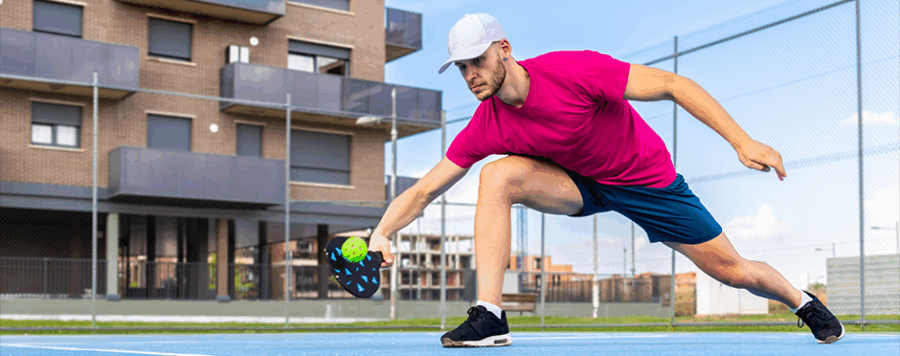Types of Stretches: Dynamic vs Static Stretches
Dynamic stretching is “active stretching,” and it involves moving a limb through the range of motion to end ranges and repeating it several times1. Dynamic stretching is ideal before workouts or competitions to warm up the muscles and prepare for the activity ahead.
Static stretching is when a position is held with the muscle on tension; static stretches are held for longer lengths of time, such as 20-30 seconds. It has been shown to help with overall flexibility and is ideal for a cool down or at the end of a workout.
Stretches for Pickleball
The areas of the body that require the most focus for stretching for pickleball include:
- Lower back
- Hips
- Knees
- Ankles
- Shoulders
Examples of Dynamic Stretches for Pickleball Players
- Arm circles: Stand with your feet shoulder-width apart, extend your arms out to the sides, and make small circles gradually increasing in size. Perform this in both directions for 30 seconds each direction.
- Leg swings: Forward/backward and side to side. Stand next to a wall or bench for support, swing one leg forward/backward, and perform 15-20 swings on each leg. You can also perform these by bringing your leg across your body and out to the side.
- Side shuffles: Shuffle sideways in both directions for a short distance of 8-10 feet several times to warm up for those quick direction changes.
- Trunk twists: Stand with feet shoulder-width apart and arms outstretched and twist your torso to the right and left in a controlled motion— it does not need to be quick — and repeat for 30 seconds.
- Forward and side lunges: Lunges can be performed standing or walking a short distance.
Examples of Static Stretches for Pickleball Players
- Cross-arm stretch: Bring one arm across your body and hold with the opposite arm. Hold for 30 seconds and perform on both sides.
- Wrist flexion and extension forearm stretch: Extend one arm forward with palm facing down, bend the wrist downward, and apply gentle pressure to the back of the hand. Repeat with the wrist bent upward. Perform on both sides.
- Standing hamstring stretch: Extend one leg forward with the heel on the ground and the toes lifted upward. Hinge forward at the hips until a stretch is felt in the back of the leg. You can also increase the stretch by placing the heel on a low bench or curb. Perform for 30 seconds and on both sides.
- Calf Stretches: Place one leg further back, with heel on the ground and toes pointed forward. end the front leg until a stretch is felt in the back of the calf. Perform for 30 seconds and on both sides.
- Quad stretch: Stand on one leg and try to bring the other foot toward the buttock, hold for 30 seconds, and perform on both sides.
Staying compliant with a stretching program before and after pickleball, can reduce the risk of injuries on the court and keep playing for many years. If you do experience aches, pains, or injuries, our team is here to help. Our movement experts will assess your condition and provide the best next steps for your fitness goals. Get started at a location near you!
*Per federal guidelines, beneficiaries of plans such as Medicare, Medicaid, Tricare, VHA and other federally funded plans are not eligible for free assessments.
The Athletico blog is an educational resource written by Athletico employees. Athletico bloggers are licensed professionals who abide by the code of ethics outlined by their respective professional associations. The content published in blog posts represents the opinion of the individual author based on their expertise and experience. The content provided in this blog is for informational purposes only, does not constitute medical advice and should not be relied on for making personal health decisions.
References:
1. Page P. CURRENT CONCEPTS IN MUSCLE STRETCHING FOR EXERCISE AND REHABILITATION. International Journal of Sports Physical Therapy. 2012;7(1):109-119.
About the Author:
Tara Hackney, a physical therapist in Marion, IA, enjoys working with all patient types, especially gymnasts, cheerleaders, and dancers. She is the prominent blogger for Athletico's Gymnastic/Cheer Program. With an orthopedic specialization and training in dry needling and Graston technique, Tara hopes to answer your questions about injuries and injury prevention in an easy-to-understand manner. She hopes to ease fears surrounding pain and injuries, address concerns about recovery, and provide tips to prevent injury. In her free time, she enjoys spending time with her dog, reading, and watching her nephews play sports.

 width="900"
height="356"
>
width="900"
height="356"
>
